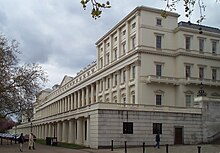ผลต่างระหว่างรุ่นของ "ราชสมาคม"
ล Geonuch ย้ายหน้า ราชสมาคมแห่งลอนดอน ไปยัง ราชสมาคม ทับหน้าเปลี่ยนทาง: ตาม Royal Society ในวิกิพีเดียภาษาอังกฤษ |
ไม่มีความย่อการแก้ไข ป้ายระบุ: เครื่องมือแก้ไขต้นฉบับปี 2560 |
||
| บรรทัด 1: | บรรทัด 1: | ||
{{Infobox organization |
|||
|name = ราชสมาคม |
|||
|image = The Royal Society Coat of Arms.svg |
|||
|caption = [[ตราอาร์ม]]ของราชสมาคม |
|||
|size = 200px |
|||
|remarks = คำขวัญ: ''[[Nullius in verba]]''<br /><small>("Take nobody's word for it")<!-- This is the RS translation; please do not change it --></small> |
|||
|formation = {{Start date and age|df=yes|1660|11|28}} |
|||
|headquarters = [[ลอนดอน]], {{postcode|SW|1}}<br>สหราชอาณาจักร |
|||
|coords = {{coord|51|30|21.53|N|0|07|56.86|W|display=inline,title}} |
|||
|leader_title = ประธาน |
|||
|leader_name = [[Venkatraman Ramakrishnan]] |
|||
|membership = {{Plainlist| |
|||
* สมาชิก ~ 1600 คน |
|||
* สมาชิกต่างชาติ ~ 140 คน |
|||
* สมาชิกหลวง 6 พระองค์}} |
|||
|website = {{URL|royalsociety.org}} |
|||
}} |
|||
[[ไฟล์:Royal_Society_20040420.jpg|thumb|สถานที่ตั้งของราชสมาคมแห่งลอนดอน]] |
[[ไฟล์:Royal_Society_20040420.jpg|thumb|สถานที่ตั้งของราชสมาคมแห่งลอนดอน]] |
||
รุ่นแก้ไขเมื่อ 21:29, 19 ธันวาคม 2562
| ไฟล์:The Royal Society Coat of Arms.svg ตราอาร์มของราชสมาคม | |
| ก่อตั้ง | 28 พฤศจิกายน 1660 |
|---|---|
| สํานักงานใหญ่ | ลอนดอน, SW1 สหราชอาณาจักร |
| พิกัด | 51°30′21.53″N 0°07′56.86″W / 51.5059806°N 0.1324611°W |
สมาชิก |
|
ประธาน | Venkatraman Ramakrishnan |
| เว็บไซต์ | royalsociety |
| หมายเหตุ | คำขวัญ: Nullius in verba ("Take nobody's word for it") |

ราชสมาคมแห่งลอนดอน (อังกฤษ: Royal Society หรือชื่อเต็มว่า The Royal Society of London for the Improvement of Natural Knowledge) เป็นสมาคมนักปราชญ์ทางวิทยาศาสตร์ธรรมชาติ รวมถึง คณิตศาสตร์ วิทยาศาสตร์ในวิศวกรรม และวิทยาศาสตร์การแพทย์ [1] มีความเป็นไปได้ว่าเป็นสมาคมที่เก่าแก่ที่สุดที่ยังคงอยู่[2] ก่อตั้งขึ้นเมื่อเดือนพฤศจิกายน ค.ศ. 1660 โดยพระบรมราชานุญาตของสมเด็จพระเจ้าชาร์ลส์ที่ 2 แห่งอังกฤษ ในชื่อ ราชสมาคมแห่งลอนดอน (Royal Society of London) เดิมทีสมาคมเป็นส่วนเพิ่มเติมของ วิทยาลัยอินวิซิเบิล (Invisible College) ที่ก่อตั้งขึ้นเพื่อเป็นสถานที่วิจัยและอภิปราย ปัจจุบันราชสมาคมเป็นผู้ให้คำแนะนำวิทยาศาสตร์แก่รัฐบาลอังกฤษ ได้รับเงินช่วยเหลือจากรัฐบาล ราชสมาคมทำหน้าที่เป็นสถาบันวิทยาศาสตร์แห่งสหราชอาณาจักร หาทุนวิจัยให้นักวิจัยและบริษัทด้านวิทยาศาสตร์
ประวัติ
เมื่อเริ่มแรก ราชสมาคมฯ เป็นกลุ่มนักวิทยาศาสตร์ประมาณ 12 คน รู้จักในชื่อ วิทยาลัยอินวิซิเบิล (วิทยาลัยที่มองไม่เห็น) โดยพบปะกันตามสถานที่ต่างๆ รวมถึงบ้านของบรรดาสมาชิกและวิทยาลัยเกรแชม สมาชิกยุคแรกๆ ได้แก่ จอห์น วิลกินส์, โจนาทาน ก็อดเดิร์ด, โรเบิร์ต ฮุก, คริสโตเฟอร์ เรน, วิลเลียม เพตตี, และ โรเบิร์ต บอยล์ โดยมาอภิปรายกันเกี่ยวกับ "วิทยาศาสตร์สมัยใหม่" ซึ่งฟรานซิส เบคอน พยายามส่งเสริมในงานเขียน New Atlantis ของเขาตั้งแต่ราว ค.ศ. 1645 เป็นต้นมา[3] ในช่วงแรกไม่มีกฎระเบียบอะไร เป้าหมายมีเพียงการรวมกลุ่มกัน ดูผลการทดลอง และแลกเปลี่ยนสิ่งที่แต่ละคนค้นพบ[4] กลุ่มมีการแปรเปลี่ยนมาตลอด ในที่สุดก็แยกออกเป็นสองกลุ่มใหญ่ๆ ในช่วง ค.ศ. 1638 คือกลุ่มสมาคมลอนดอน กับสมาคมออกซฟอร์ด เนื่องมาจากปัญหาในการเดินทาง กลุ่มออกซฟอร์ดนั้นกระตือรือร้นกว่าเพราะสมาชิกส่วนใหญ่ของวิทยาลัยพำนักอยู่ที่นั่น ต่อมาจึงก่อตั้งเป็น สมาคมปรัชญาแห่งออกซฟอร์ด (The Philosophical Society of Oxford) ดำเนินการภายใต้กฎเกณฑ์จำนวนหนึ่งซึ่งยังคงดำรงอยู่โดยห้องสมุด Bodleian[5]
อ้างอิง
- ↑ Anon (2015). "Royal Society Elections". London: Royal Society. คลังข้อมูลเก่าเก็บจากแหล่งเดิมเมื่อ 2015-09-06.
- ↑ สมาคมวิทยาศาสตร์เลโอโปลดินาแห่งเยอรมัน (German Academy of Sciences Leopoldina, Deutsche Akademie der Naturforscher Leopoldina) อ้างว่าเป็นสมาคมที่ตั้งอยู่อย่างต่อเนื่องยาวนานที่สุด ด้วยสามารถสืบค้นประวัติย้อนไปได้ถึงปี ค.ศ. 1652 ในชื่อเรียกว่า Academia Naturae Curiosorum อย่างไรก็ดี ราชสมาคมแห่งลอนดอนนั้นเข้าอยู่ในพระบรมราชูปถัมภ์ในปี ค.ศ. 1660 ขณะที่เลโอโปลดินายังไม่ได้รับอุปถัมภ์อย่างเป็นทางการเลยจนกระทั่งถึงปี ค.ศ. 1687
- ↑ Syfret (1948) p.75
- ↑ Sprat (1722) p.56
- ↑ อ้างอิงผิดพลาด: ป้ายระบุ
<ref>ไม่ถูกต้อง ไม่มีการกำหนดข้อความสำหรับอ้างอิงชื่อsy1s
บรรณานุกรม
- Bluhm, R.K. (1958). "Remarks on the Royal Society's Finances, 1660–1768". Notes and Records of the Royal Society of London. The Royal Society. 13 (2): 82. doi:10.1098/rsnr.1958.0012.
- de Beer, E.S. (1950). "The Earliest Fellows of the Royal Society". Notes and Records of the Royal Society of London. The Royal Society. 7 (2): 172. doi:10.1098/rsnr.1950.0014.
- J.D.G.D. (1938). "The Arms of the Society". Notes and Records of the Royal Society of London. The Royal Society. 1 (1): 37. doi:10.1098/rsnr.1938.0007.
- Fischer, Stephanie (2005). "Report: The Royal Society Redevelopment". Notes and Records of the Royal Society of London. The Royal Society. 59 (1): 65. doi:10.1098/rsnr.2004.0077.
- Hall, Marie Boas (1981). "Public Science in Britain: The Role of the Royal Society". Isis. University of Chicago Press. 72 (4): 627–629. doi:10.1086/352847.
- Henderson, L.J. (1941). "The Royal Society". Science. American Association for the Advancement of Science. 93 (2402): 27. doi:10.1126/science.93.2402.27. PMID 17772875.
- Hunter, Michael (1984). "A 'College' for the Royal Society: The Abortive Plan of 1667–1668". Notes and Records of the Royal Society of London. The Royal Society. 38 (2): 159. doi:10.1098/rsnr.1984.0011.
- Lyons, H.G. (1938). "The Growth of the Fellowship". Notes and Records of the Royal Society of London. The Royal Society. 1 (1): 40. doi:10.1098/rsnr.1938.0008.
- Lyons, H.G. (April 1939). "Two Hundred Years Ago. 1739". Notes and Records of the Royal Society of London. The Royal Society. 2 (1): 34. doi:10.1098/rsnr.1939.0007.
- Lyons, H.G. (November 1939). "One Hundred Years Ago. 1839". Notes and Records of the Royal Society of London. The Royal Society. 2 (2): 92. doi:10.1098/rsnr.1939.0016.
- Lyons, H.G. (1939). "The Composition of the Fellowship and the Council of the Society". Notes and Records of the Royal Society of London. The Royal Society. 2 (2): 108. doi:10.1098/rsnr.1939.0017.
- Lyons, H.G. (1940). "The Officers of the Society (1662–1860)". Notes and Records of the Royal Society of London. The Royal Society. 3 (1): 116. doi:10.1098/rsnr.1940.0017.
- Martin, D.C. (1967). "Former Homes of the Royal Society". Notes and Records of the Royal Society of London. The Royal Society. 22 (1/2): 12. doi:10.1098/rsnr.1967.0002.
- Miller, David Philip (1998). "The 'Hardwicke Circle': The Whig Supremacy and Its Demise in the 18th-Century Royal Society". Notes and Records of the Royal Society. The Royal Society. 52 (1): 73. doi:10.1098/rsnr.1998.0036.
- A.C.S. (1938). "Notes on the Foundation and History of the Royal Society". Notes and Records of the Royal Society of London. The Royal Society. 1 (1): 32. doi:10.1098/rsnr.1938.0006.
- Sorrenson, Richard (1996). "Towards a History of the Royal Society in the Eighteenth Century". Notes and Records of the Royal Society of London (free access). The Royal Society. 50 (1): 29. doi:10.1098/rsnr.1996.0003.
{{cite journal}}:|format=ต้องการ|url=(help) - Sprat, Thomas (1722). The history of the Royal Society of London: for the improving of natural knowledge. By Tho. Sprat. Samuel Chapman. OCLC 475095951.
- Summerson, John (1967). "Carlton House Terrace". Notes and Records of the Royal Society of London. The Royal Society. 22 (1): 20. doi:10.1098/rsnr.1967.0003.
- Syfret, R.H. (1948). "The Origins of the Royal Society". Notes and Records of the Royal Society of London. The Royal Society. 5 (2): 75. doi:10.1098/rsnr.1948.0017.
- Robinson, H.W. (1946). "The Administrative Staff of the Royal Society, 1663–1861". Notes and Records of the Royal Society of London. The Royal Society. 4 (2): 193. doi:10.1098/rsnr.1946.0029.
